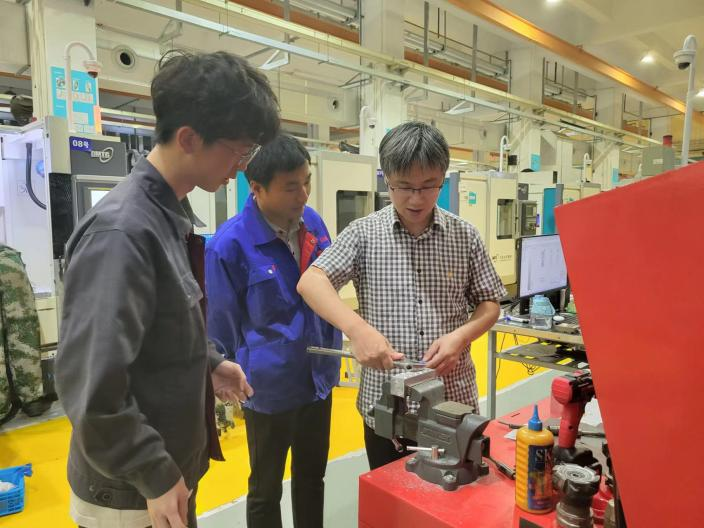Editor's Note: On November 16, the WeChat public account "Shanghai Higher Vocational Education" published a profile interview with our teacher Mr. Wang Hao from the Manufacturing Engineering Department, introducing his career development from a mold technician to a "3D printing magician", showcasing the artisan spirit of striving for excellence, exploring the limit, and our teachers' selfless dedication and the elegance of vocational education combining morality and skill.

Introduction of Mr. Wang Hao:
Senior Practical Educator in the Manufacturing Engineering Department of the Higher Vocational College of Shanghai University of Engineering Science
Shanghai City First and Second Level Mold Worker Vocational Qualification Assessor
Shanghai City Technician (2021)
Mr. Wang Hao has been engaged in mold design and manufacturing teaching for 19 years, and he is the head of the “3D Printing and Modeling” (Special Vocational Ability) assessment project development team.

Mr. Wang Hao, one of the first teachers to get in touch with 3D printing in the Higher Vocational College of Shanghai University of Engineering Science, is also a Shanghai city technician. In the conversation with Mr. Wang, you will be attracted by his firm, calm tone and the light in his eyes. How did he come into contact with 3D printing, and how does he shine in his position?
Five Years to Polish One's Insight
Before becoming a teacher, Mr. Wang Hao had been learning mold manufacturing from his master. He most admired his master's ability to diagnose mechanical equipment problems at a glance and identify the causes of these problems. Although the precise machinery often has complex problems, the master has accumulated abundant experience and superior observation ability through years of practice, with his prediction accuracy of problem causes almost as high as 90%. At that time, Mr. Wang silently made up his mind to become a solid, high-level mold worker like his master.
After becoming a vocational teacher, Mr. Wang's classes are always full of useful knowledge. He would teach students his years of practical experience and frontline work experience without reservation. Mr. Wang loves the identity of "teacher". In his eyes, every student is a shining gold, and they are also his learning objects. Each year's vocational skills competition will involve the latest knowledge points in the technical field. When encountering problems during training, Mr. Wang and the team members will sit down and discuss countermeasures. "Although the students are inexperienced, their thinking activity far exceeds that of us old teachers. Sometimes their solutions may not be practical, but the problem-solving thinking is something I have never thought of." The innovative talent of young people makes Mr. Wang happy, "The progress and growth of students are my greatest achievements."
Falling into the Pit out of Curiosity
How many steps does it take to make a hundred percent restored "Iron Man" model? If traditional mold manufacturing methods are used, the answer is countless. Because traditional mold making is a processing method based on "trimming", it requires a "cut here" and a "trim there" to get the desired parts. This processing method often takes more time and causes waste of materials. If 3D printing is used, making the "Iron Man" model becomes much simpler. Design the body and armor data of the "Iron Man" in the program, and then the 3D printer can make the materials into a beautiful "Iron Man" model bit by bit.
In 2013, the Higher Vocational College of Shanghai University of Engineering Science introduced its first 3D printer. Mr. Wang was immediately attracted by this new technology. The 3D printer is completely different from the heavy "giants" such as lathes and hydraulic machines that he usually contacts. It is delicate, flexible, and can "create out of nothing" like a "magician".
The new technology that opens up another way changed Mr. Wang's impression of mold making, "3D printing almost does not waste materials, and can quickly turn imagination into reality. I felt at the time that 3D printing will definitely have wider uses in the future." With strong curiosity and novelty, Mr. Wang became the first batch of "pioneers" studying 3D printing technology in the school.

Just in the second year when Mr. Wang began to concentrate on studying 3D printing technology, the National Vocational College Skills Competition included it in the competition items. The rapid advancement of 3D printing technology prompted Mr. Wang to continuously improve his skills during the preparation and competition process. "Mold manufacturing pursues that there is no best, only better, and 3D printing is the same. If the product accuracy reaches 1mm this year, then we must find a way to do 0.1 mm next year. After the technology reaches a certain height, there are new heights to follow." When Mr. Wang said this, there was light in his eyes. In his world, the spirit of a craftsman is consistent with the core ability of manufacturing, that is, constantly exploring the limits of oneself.